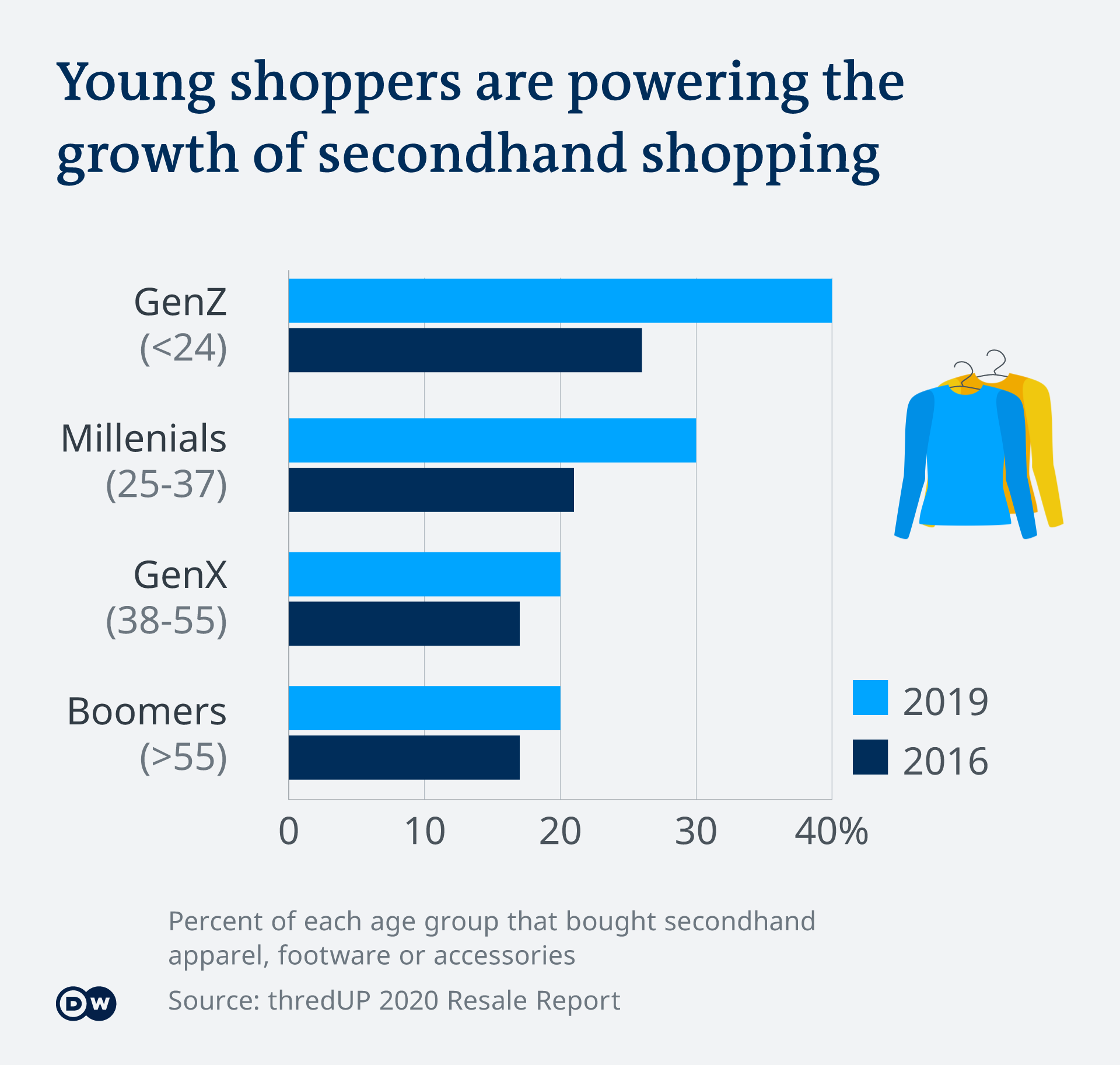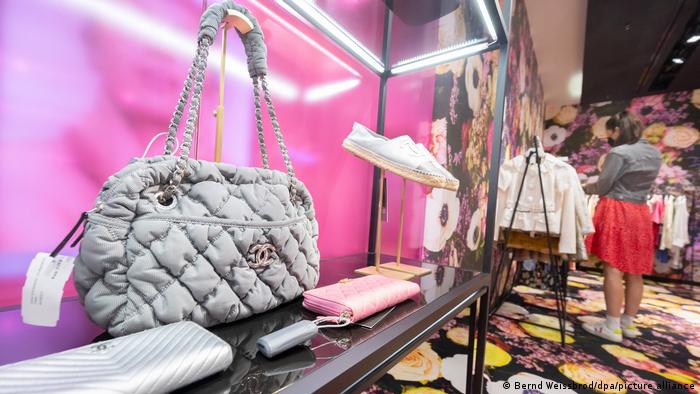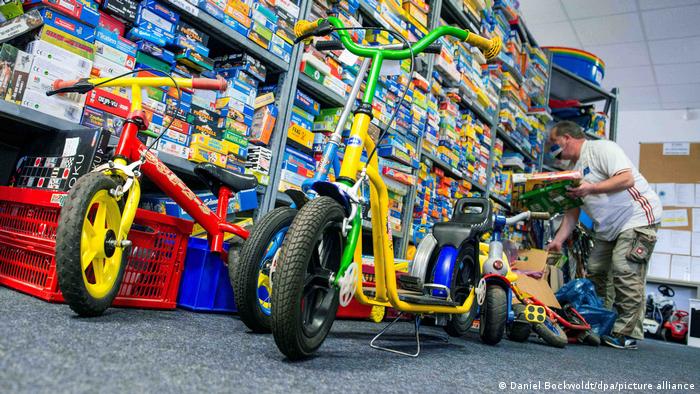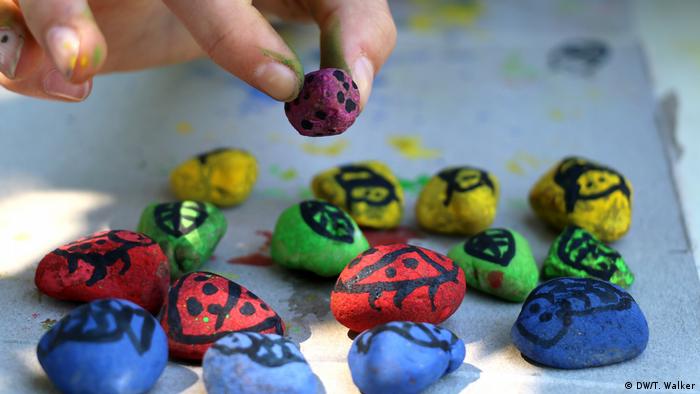It is a grey, rainy December afternoon in Cologne. The shop windows at the Oxfam thrift shop on Cologne’s Friesenplatz bustle with activity, unlike the street outside. Every Wednesday afternoon, the shop windows get a makeover. This week, the display is dedicated to Christmas, and is complete with golden baubles and bowls, a champagne bottle and glasses to match.
All the items that volunteers sell are donated and most of them are second-hand. All profits are donated to Oxfam to allow it to achieve its development goals according to its mission statement.
“Aside from decorations, the most-bought items over the Christmas period are books and cute little things such as nice cups or toys,” said Steffi Müller, who has worked in the Friesenplatz store for 10 years now. Over that time, she has seen more and more demand for products other than clothes during the Christmas season.
Matthias Scholl, Oxfam’s regional manager in southern and western Germany, agrees with her observations. “For many years, we have seen an increase in demand towards the end of each year at the 55 Oxfam shops that we run across the country. Sales are approximately 10% higher in the run-up to Christmas than the average annual.
Does this mean that more people are happy with used — and therefore sustainable — gifts?
Secondhand is socially acceptable
Secondhand seems to be becoming more mainstream. Otto Group published a 2020 study on ethical consume, which found 73% of respondents liked the ability to purchase or sell secondhand items, such as old furniture or fashion.
According to trend researcher Peter Wippermann, who led the study, this shift in consumer behavior is driven by younger generations who are less interested in having new things than in getting what they want when they want it, and not having to spend much in the process.
“New no longer has to mean brand-new,” said Wipperman, adding that the trend has spread beyond just fashion and other fast-moving goods to areas such as mobility. “It’s important to have the ability to drive whenever you wish, but not to own your vehicle.”
And the world of secondhand is now shedding its musty flea-market image. Large internet marketplaces allow people to sell and buy used goods. Words like “preloved,” are replacing “secondhand”

Internet driving secondhand market
Vinted is one of these online platforms for secondhand fashion. It was formerly known under the name Kleiderkreisel. Vinted conducted a survey in the United Kingdom, France and Germany, and 56% of those surveyed said that they would prefer to get or receive a mixture of new and used Christmas gifts. Another 14% stated that they planned to purchase only secondhand gifts for Christmas this year.
Such peer-to-peer platforms, in which users buy and sell directly from each other, have been a huge boost to the secondhand market, according to Carl Tillessen, a trend analyst at German Fashion Institute, a Cologne-based company that researches fashion developments.
“The secondhand market faces serious challenges in that every item must somehow be found the right person to purchase it. He said that the internet allows this to be done, at a cost-efficient and hygienic manner, without any extra transport or storage.
How durable is preloved?
Tillessen said that sustainability is not the main concern for many sellers and buyers on secondhand marketplaces. In a Boston Consulting Group survey of over 7,000 respondents from six countries, 36% said that they were motivated by sustainability when shopping. Instead, issues such as good value, a large product range and current trends took precedence.
For Generation Z — those who were born between the late 1990s and the early 2010s —secondhand clothes are seen as a kind of fast fashion, said Tillessen. They quickly sell what they don’t want. This is different from the world of new fast fashion, in which new clothes are bought cheaply, worn briefly, and then thrown away.
Viola Muster, head of the Technical University of Berlin’s department of economic education, stated that in principle people buying secondhand goods is good for sustainability.
But that can’t be combined with purchasing more products. It’s a classic bounce effect: “I have saved money because I bought the secondhand product for a cheap price. I can then spend the savings on other consumer products.” It doesn’t do anything,” she stated.
Who doesn’t love receiving second-hand gifts?
But is it OK to gift a preloved scarf on its own, rather than as an accompaniment to another new gift? It all depends on the recipient’s age, according to Tillessen. Although younger generations are more likely to appreciate secondhand gifts than older generations, they feel less valued if the gift has been used.
It is all about exclusivity. That something was made just for me and that I get the privilege of being the first user — that I believe is deeply ingrained in older generations,” he said. Wipperman, a trend analyst, confirmed this idea. He said that “Consumption was once a strong indicator of social clout. However, used goods were a sign for social weakness.”
The psychology behind giving
Muster said that people who give gifts are making a statement about their self-worth. “That especially applies if the gift giver and receiver are not close. In such relationships, we therefore often tend toward new presents,” she said.
One way to get around that problem and still be sustainable is to give people a gift card for a secondhand shop or online platform, she said.
Bernd Stauss, emeritus professor of business administration at the Catholic University of Eichstätt-Ingolstadt, knows well the connections between gifting and diplomacy, communication and unwritten rules. He has recently published a book about the psychology of gifting.
Gifts that are perceived as being patronizing are the least popular. The gift giver should send the message, “I want you to change,” he explained to DW. This is something you should be very careful about when you give secondhand gifts.
However, empirical research shows that gift giving is primarily about the symbolism of the present. This applies regardless of its age.
“That means how much empathy was involved, what effort has been put into the gift or whether the gift represents some kind of sacrifice,” said Strauss.
Gifting family jewelry to someone could be considered a great symbol of sacrifice. However, it is a different story if someone wants to get rid off cufflinks that they don’t wear. He stated that it depends on whether the recipient is motivated by their interests or tastes.
Alistair Walsh translated this article from German











